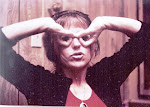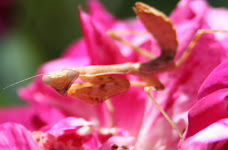
A Confederacy of Women
If you walk up the stairs of the great old barn,
you enter the loft where the looms are stored.
The wood-planked space is filled with looms,
with spinning wheels, a room of women.
Some of the ancient looms resemble racks
to which someone could be strapped and
forced to tell the truth. Some are ready
with warp and weft to be woven into cloth.
Upon the spinning wheels you might expect
to see the women of fairy tales, spinning for
their lives or for malice of others. Prick
your finger and blood will rise up, so near
sigh the tales of women past. Though women
at this moment sit with spindles in their hands,
those who came before are present tangibly
in spirits of such strength, you may feel them
in the wood, the ancient wood hewn at the
dawn of time, or nearly. You may feel their pulses
faintly in the cells of wood worn comfortably
to fit the feminine form. Lean your forehead against
an upright of the oldest loom and close your eyes.
See them, all of them who went before, with
lean, strong fingers weaving, weaving, weaving
shrouds for babies, shrouds for men, shrouds
for mothers, fathers, sons and daughters, shrouds
long gone with the bones to dust. The women
bend slightly, firmly over the work of their
hands, weaving goods to fill their lives:
wedding gowns, diapers, menstrual cloths,
the sacred relics of womanhood, woven
on these looms like wombs sheltering the
confederacy of women still to come.
The weavers society in our rural neck of the woods hold their annual sale this time of year. You’ll find spun cloth, woven clothing, scarves of every color. You’ll find tapestries of artistic quality, and it is all held in a renovated barn. Last year I bought scarves woven of silk thread spun with fingers knarled with arthritis to give as gifts, and beautiful cloths in luscious colors. I bought myself two hats of hand-spun yarn, and I’m in love with them.
If you walk up the stairs of the great old barn,
you enter the loft where the looms are stored.
The wood-planked space is filled with looms,
with spinning wheels, a room of women.
Some of the ancient looms resemble racks
to which someone could be strapped and
forced to tell the truth. Some are ready
with warp and weft to be woven into cloth.
Upon the spinning wheels you might expect
to see the women of fairy tales, spinning for
their lives or for malice of others. Prick
your finger and blood will rise up, so near
sigh the tales of women past. Though women
at this moment sit with spindles in their hands,
those who came before are present tangibly
in spirits of such strength, you may feel them
in the wood, the ancient wood hewn at the
dawn of time, or nearly. You may feel their pulses
faintly in the cells of wood worn comfortably
to fit the feminine form. Lean your forehead against
an upright of the oldest loom and close your eyes.
See them, all of them who went before, with
lean, strong fingers weaving, weaving, weaving
shrouds for babies, shrouds for men, shrouds
for mothers, fathers, sons and daughters, shrouds
long gone with the bones to dust. The women
bend slightly, firmly over the work of their
hands, weaving goods to fill their lives:
wedding gowns, diapers, menstrual cloths,
the sacred relics of womanhood, woven
on these looms like wombs sheltering the
confederacy of women still to come.
The weavers society in our rural neck of the woods hold their annual sale this time of year. You’ll find spun cloth, woven clothing, scarves of every color. You’ll find tapestries of artistic quality, and it is all held in a renovated barn. Last year I bought scarves woven of silk thread spun with fingers knarled with arthritis to give as gifts, and beautiful cloths in luscious colors. I bought myself two hats of hand-spun yarn, and I’m in love with them.
What struck me most profoundly was not the beauty of the weaving but the upstairs looms, spindles, spinning wheels, many so old their wood shone. One loom was made when Dolly Madison was lady of the White House, and used continually since. Its wood was dark with age and well worn by the backsides and hands of women long gone.
It marvels me that we return to crafts long performed by women down the ages. Some of the weavers were elderly, and many were my age and younger.
Poets have scribbled ink on papyrus and parchment through the millenniums for the compulsion to capture human experience. Artists have drawn in caves.
It seems the human family is compelled to create beauty, not just utilitarian tools. I take heart in this. There is an indomitable spirit in the human being. We’re not just warmongers and capitalists and listless souls. We are people of art and craftsmanship as well. Thank God.
Photo courtesy maidensmemoirs






wickipedia.jpg)






 Today has been my special day since I first learned it was my birthday. I thank God for the gifts in my life. I honor myself for the wisdom I have attained, and the growth I have before me. I have gorgeous red and purple-tiger roses blooming for this special day in November. I also had the most monster sycamore leaf drop into the birdbath and I'll treat you to that.
Today has been my special day since I first learned it was my birthday. I thank God for the gifts in my life. I honor myself for the wisdom I have attained, and the growth I have before me. I have gorgeous red and purple-tiger roses blooming for this special day in November. I also had the most monster sycamore leaf drop into the birdbath and I'll treat you to that.



























